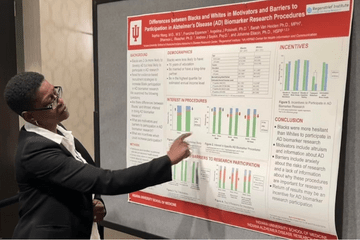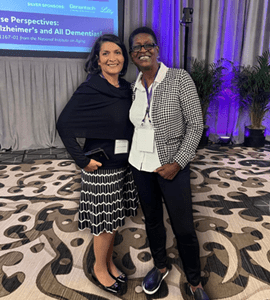A future for the taking
When she first moved to Indianapolis, Francine Epperson was working as a nanny and personal assistant; however, after some time she realized she wanted to do more and ensure her children saw that they could achieve anything they wanted in life.
“I didn’t want my kids to think that this is all that they could be,” said Epperson. “I wanted them to know that they can’t let the system stop them, and to always climb toward their dream.”
Epperson made it a goal to get a job at IU to challenge herself and continue to learn. Eventually, she connected with Bernardino Ghetti, MD, who opened the door to neuropathology and her involvement with the IADRC. As the years progressed, Epperson continued her education while working full-time, eventually earning an associate degree. For years, she dove into research efforts with Ghetti and other IADRC faculty members, eventually getting involved in the dissection and dictation aspects of brains at the time of autopsy for neuropathology research laboratories. Additionally, she bridged the gap between research and local African American families impacted by Alzheimer’s disease. In fact, her outreach efforts have helped ensure African American and Black families in and around Indianapolis understand the significance of their involvement in research and the answers it can provide their loved ones.
The benefit of research participation
The Alzheimer’s Association has stated that “while older Black Americans are twice as likely as older Whites to have Alzheimer's or another dementia, research hasn't yet identified the cause.” To help this cause and better support those most impacted by this disease, the IADRC is working to better address the barriers to research participation for Black individuals, and Epperson and the IADRC’s Outreach, Recruitment and Engagement Core are at the steering wheel of this work.
Epperson has been heavily involved in this effort and recently presented research at the 2022 Alzheimer’s Association Addressing Health Disparities Conference. Her presentation, titled “Differences in Motivators, Barriers, and Incentives between Black and White Older Adults for Participation in Alzheimer’s Disease Biomarker Research,” highlighted what encourages and prevents Black individuals from participating in Alzheimer’s research.
“Minority participation is key, as we’re often the left-behind group,” Epperson said.
In this research, Epperson and her colleagues found  that individuals, both Black and white, felt that they weren’t knowledgeable enough to make an informed decision about participating in Alzheimer’s disease biomarker research. As a result, the IADRC is ramping up efforts to provide more educational resources as well as opportunities for community members to speak with staff and faculty face-to-face.
that individuals, both Black and white, felt that they weren’t knowledgeable enough to make an informed decision about participating in Alzheimer’s disease biomarker research. As a result, the IADRC is ramping up efforts to provide more educational resources as well as opportunities for community members to speak with staff and faculty face-to-face.
Epperson and her team also found that along with a lack of information, anxieties about the risks of research and research procedures presented unique barriers to participation. But what was unique is that they discovered how altruism, gaining knowledge about Alzheimer’s disease and witnessing results were important motivators and incentives for research participation.
In addition to presenting at the conference, Epperson won the Lightning Presentation Round, where she had only five minutes to effectively present and provide conclusions on the research being done at the IADRC. Not only did Epperson win this important award, but she was acknowledged by Maria Carrillo, PhD, chief science officer for the Alzheimer’s Association, as well as other key figures in the world of Alzheimer’s research.
“When the public can see a real person who isn’t an MD or PhD doing something to make a real change in disparities in health care, they see themselves,” said Epperson.
The significance of precision medicine
The IADRC is connecting with Black Hoosiers to understand their histories and past experiences with health care and research, especially when it comes to bias. By approaching each individual and family, and sharing with them information about Alzheimer’s disease, Epperson has witnessed more Black individuals get involved or express interest in Alzheimer’s research participation.
“Precision medicine is the only way to help people,” she said. “It allows us to not just look at someone as a statistic, but as a person with a unique history and relationship with this disease.”
By understanding patients as individuals with different experiences, it’s evident that research will only be as good as the connection and representation it has to the community it serves and those most impacted.
Epperson is a representation of how the IADRC is improving efforts in precision medicine and community outreach for Indianapolis and beyond. To date, she has over 50 publications and posters to her name. Her decades of work have advocated for those left behind in Alzheimer’s research and helped shape its future.
“When folks see that not only am I someone who isn’t a physician but that I’m excelling in the field of research and that I look like them— they see themselves, and it becomes more of a reality that they too can make a difference,” Epperson said.
Learn more about Alzheimer’s disease and how to get involved in research participation at the Indiana Alzheimer’s Disease Research Center.
